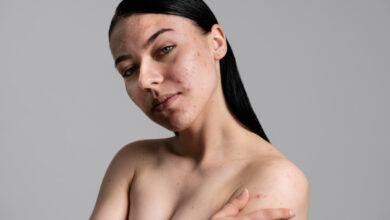C-Section and Hives: What to Expect and How to Cope

While the joy of welcoming a newborn is unparalleled, the postpartum period can sometimes bring unexpected challenges. One such concern for some new mothers is the development of hives after C-section. This article dives into the potential connection between C-sections and hives, explores the causes and symptoms, and offers coping strategies. With this knowledge, new mothers can navigate this stressful situation with confidence and find relief.
Decoding Hives: A Disruption in Skin Harmony
Hives, medically known as urticaria, are raised, itchy red welts, often accompanied by a burning sensation, that can appear on the skin. They can develop suddenly and vary in size and shape, often changing location within hours. Hives typically resolve within 24 hours, but in some cases, they may persist for weeks or even months (chronic urticaria). The precise cause of hives is often unclear, but the origin of the itchy outbreak can be traced back to the body’s immune system.
The Potential Link Between C-Sections and Hives
In the context of a C-section, hives can be particularly distressing for new mothers who are already navigating the physical and emotional challenges of childbirth. The surgical nature of C-sections involves a disruption of the skin barrier, which, when combined with the hormonal fluctuations typical postpartum, may create conditions conducive to the development of hives.
According to the American Academy of Allergy, Asthma & Immunology, hives emerge as a result of the body’s response to allergens or stressors, triggering the release of histamine and other chemicals into the bloodstream. This response can stem from a range of factors, including medications administered during and after surgery, heightened stress levels, or an allergic reaction to materials utilized during the procedure.
Prevalence of Hives After C-Section
The prevalence of hives following a C-section is not extensively documented, but they are considered a relatively rare complication. According to a study published in the Journal of Clinical Medicine, approximately 0.3-1% of women experience hives after C-section. This statistic underscores the importance of awareness and preparedness for this potential issue.
Factors influencing the prevalence include individual allergic predispositions, the use of specific medications, and the presence of other conditions such as asthma or eczema. For instance, women with a history of allergic reactions or those who have experienced hives previously are more likely to develop them post-surgery.
Understanding the prevalence helps in early recognition and management, ensuring that affected individuals receive prompt and effective care.
Causes of Hives After C-Section
- Food Allergies: Certain foods, such as nuts, shellfish, eggs, and dairy, can induce allergic reactions manifesting as hives.
- Medications: Antibiotics, pain relievers, and anesthesia used during and after a C-section can sometimes trigger allergic reactions, leading to hives. For example, opioids used for pain management are known to cause histamine release in some individuals.
- Stress: The physical stress of surgery combined with the emotional stress of childbirth can trigger hives. Stress-induced hives are common and can exacerbate due to sleep deprivation and hormonal changes postpartum.
- Infections: Post-surgical infections, although rare, can sometimes present hives as a symptom. It is crucial to monitor for other signs of infection, such as fever, increased pain, or discharge from the surgical site.
Diagnosis of Hives After C-Section
Diagnosing hives after C-section involves a thorough assessment by a healthcare provider, including:
- Medical History: Reviewing the patient’s medical background to identify potential triggers and underlying conditions.
- Physical Examination: Observing the characteristics of the welts to distinguish hives from other skin conditions.
- Allergy Testing: Conducting skin prick tests or blood tests to pinpoint allergens, particularly if medication or material allergies are suspected.
- Laboratory Tests: Checking for underlying conditions like thyroid disorders or autoimmune diseases through blood tests.
- Challenge Tests: Administering controlled doses of suspected medications to observe reactions, especially in medication-induced hives.
An early and precise diagnosis is crucial for efficiently handling a situation. Prompt and precise diagnosis is crucial for efficient management.
Recognizing the Signs: A Quick Quiz
Identifying hives can sometimes be straightforward but distinguishing them from other skin conditions can be challenging. Here is a quick quiz to help identify whether the symptoms you are experiencing might be hives:
Appearance: Do you have raised, red or skin-colored welts on your skin?
- Yes
- No
Itchiness: Are the welts extremely itchy and do they cause discomfort?
- Yes
- No
Duration: Do the welts come and go, often changing locations within a few hours to a day?
- Yes
- No
Trigger Events: Have you recently undergone surgery, started a new medication, or experienced significant stress?
- Yes
- No
Exacerbation: Do the welts worsen with heat, pressure, or stress?
- Yes
- No
If you answered “Yes” to most of these questions, it is possible that you are experiencing hives. Seeking guidance from a healthcare professional for an accurate diagnosis and suitable treatment is essential.
Coping with Hives: Strategies and Treatment
Managing hives after C-section involves a combination of medical treatment and self-care strategies. The following tips can help alleviate symptoms and prevent further outbreaks:
- Medication: Antihistamines are the first line of treatment for hives. They help block the action of histamine, providing relief from itching and swelling. In more severe cases, corticosteroids or epinephrine injections may be necessary.
- Steering clear of triggers: Recognizing and evading familiar triggers is essential. This can include certain foods, medications, or environmental factors. Keeping a diary of outbreaks can help pinpoint specific triggers.
- Stress Management: Incorporating stress-reducing practices such as deep breathing exercises, meditation, or yoga can help manage stress levels, which may, in turn, reduce the occurrence of hives after C-section. Ensuring adequate rest and seeking support from family and friends can also be beneficial.
- Topical Treatments: Applying cool compresses or calamine lotion can provide temporary relief from itching. Avoiding hot showers and wearing loose-fitting, breathable clothing can also help prevent irritation.
For more detailed information on managing this condition, you can refer to: Tips to Avoid Hives after C-Section.
Long-Term Management and Prevention
While many cases of hives after C-section resolve on their own, chronic, or recurrent hives may require long-term management strategies. Working closely with a healthcare provider to develop a personalized treatment plan is essential. This plan may include regular use of antihistamines, lifestyle modifications, and monitoring for any changes in symptoms.
Emotional and Psychological Impact
The emotional and psychological impact of dealing with hives postpartum should not be underestimated. New mothers are naturally prone to experiencing postpartum depression and anxiety, and coping with a troublesome skin condition on top of that can become quite burdensome. It is important for healthcare providers to address these aspects and offer comprehensive support, including counseling or support groups if needed.
The Role of Clinical Trials and Research
Ongoing research and clinical trials are essential in improving our understanding and treatment of hives after C-section. Participation in Revival clinical trials can offer access to new treatments and contribute to the advancement of medical knowledge. The Hives Treatment After C-Section study provides valuable insights into emerging therapies and management techniques.
Conclusion: Your Path to Well-being After Hives
The postnatal period is a time of significant adaptation. While hives can be an unwelcome addition to this already demanding phase, with proper understanding and management, they can be effectively controlled. By staying informed, seeking timely medical advice, and adopting appropriate coping strategies, mothers can navigate this challenge with greater ease and confidence. Remember, you can embrace motherhood with confidence and a newfound comfort in your own skin.



